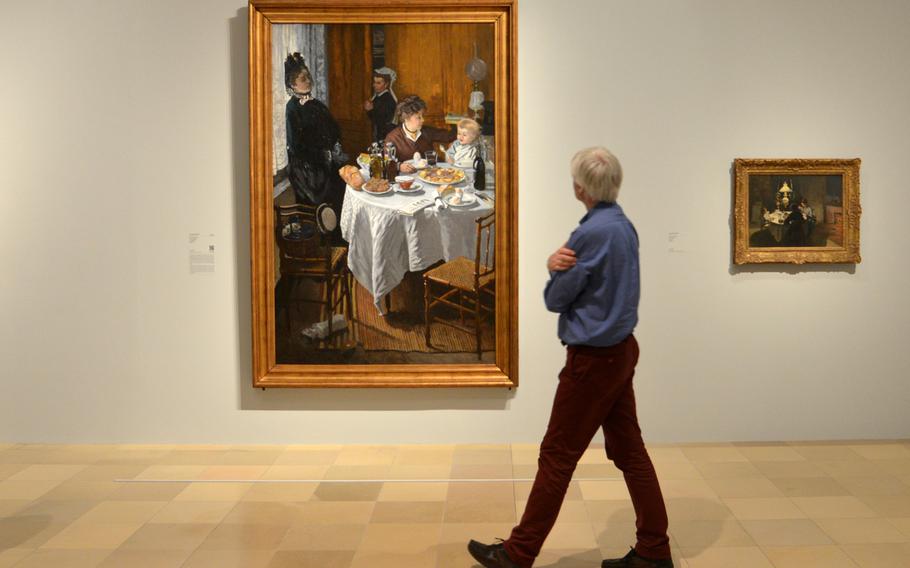
A visitor looks at Claude Monet's "The Luncheon" from 1868/69. This painting, along with another with the same name from 1873, are the centerpieces of the the "Monet and the Birth of Impressionism" exhibit at the Städel in Frankfurt, Germany. (Michael Abrams/Stars and Stripes)
FRANKFURT, Germany — The venerable Städel art institute in Frankfurt, Germany, celebrates its 200th birthday this year. Instead of receiving presents, the museum is giving art fans an exhibit that will probably be the highlight of the year.
The “Monet and the Birth of Impressionism” exhibit is made up of 100 pieces of art from the Impressionism and pre-Impressionism era. While, as the title suggests, most of the works are by Claude Monet, other artists featured are Auguste Renoir, Camille Pissarro, Berthe Morisot, Alfred Sisley, Paul Cézanne and Édouard Manet to name a few.
Impressionism is not an easy style to explain. At its simplest, one could say before the Impressionist era, the artist’s goal was to paint a scene as exact as possible. For the Impressionist, however, it was his/her impression of that scene.
The show is divided into four sections over two floors. The prologue features pre-Impressionist paintings, mostly landscapes from the “Barbizon School,” that were an early influence on the Impressionists. The next section is the earliest Impressionist works followed upstairs by the later works followed by an epilogue made up of Renoir’s diffused paintings of London bridges and the cathedral of Rouen.
The centerpiece of the exhibit are two paintings by Monet, one on each floor, both titled “The Luncheon.”
The first, painted in 1868/69, is a work that depicts his family at lunch.
One of the things that make it special is its size at more than 7.5 feet tall and almost 5 feet wide. At the time, only paintings for aristocracy and the church were done that large. This painting, however, was of the artist’s girlfriend (later wife) Camille and their illegitimate child at lunch.
Monet submitted the painting to the Paris Salon, France’s — if not the world’s — top art exhibit at the time, but it was rejected.
In 1874, artists got together for the first Impressionist exhibit in defiance of and competition to the Salon, and “Impressionism” was officially born.
The second “Luncheon” was done in 1873. Although painted only four years later, the depiction has changed. While the first one focused more on the family at the table, the latter’s focus is solely on the table. Adults are in the background and Monet’s son sits on the ground in the shadows. For the artist, objects were now important, not people.
Another of Renoir’s paintings worth noting is “The Boulevard des Capucines” from 1873. In this rendition of the Paris street, the artist has reduced the people on the street to lines and brushstrokes, giving the scene a feeling of continuous motion.
While we have concentrated on Monet’s work here, the other artists’ paintings are no less fascinating. A couple of favorites are Renoir’s “After the Luncheon,” Edgar Degas’ “Dancers in the Classroom” or Morisot’s “Eugene Manet on the Isle of Wight.”
If you enjoy Impressionism, this is one exhibit you will not want to miss. With works borrowed from, among others, the Musée d’Orsay in Paris, the Philadelphia Museum of Art, the Hermitage in St. Petersburg and the National Gallery of Art in Washington D.C., it will be a long time before you can see these Impressionist masterpieces in one place.
----------
Know and go:
The Monet exhibit at the Städel (Schaumainkai 63, 60596 Frankfurt am Main) runs until June 21.
It is open Tuesdays, Wednesdays, Saturdays, Sundays and holidays from 10 a.m. to 7 p.m., and Fridays and Saturdays from 10 a.m. to 9 p.m. It is closed Mondays.
Admission is 14 euros. Children under 12 are free. There is a family pass available for two adults and at least one child for 24 euros. It is advised to buy tickets online to avoid the lines.
Before you go, check out the Städel’s so-called digitorial, a multimedia feature about the exhibit and all the info about going at http://monet.staedelmuseum.de/en/